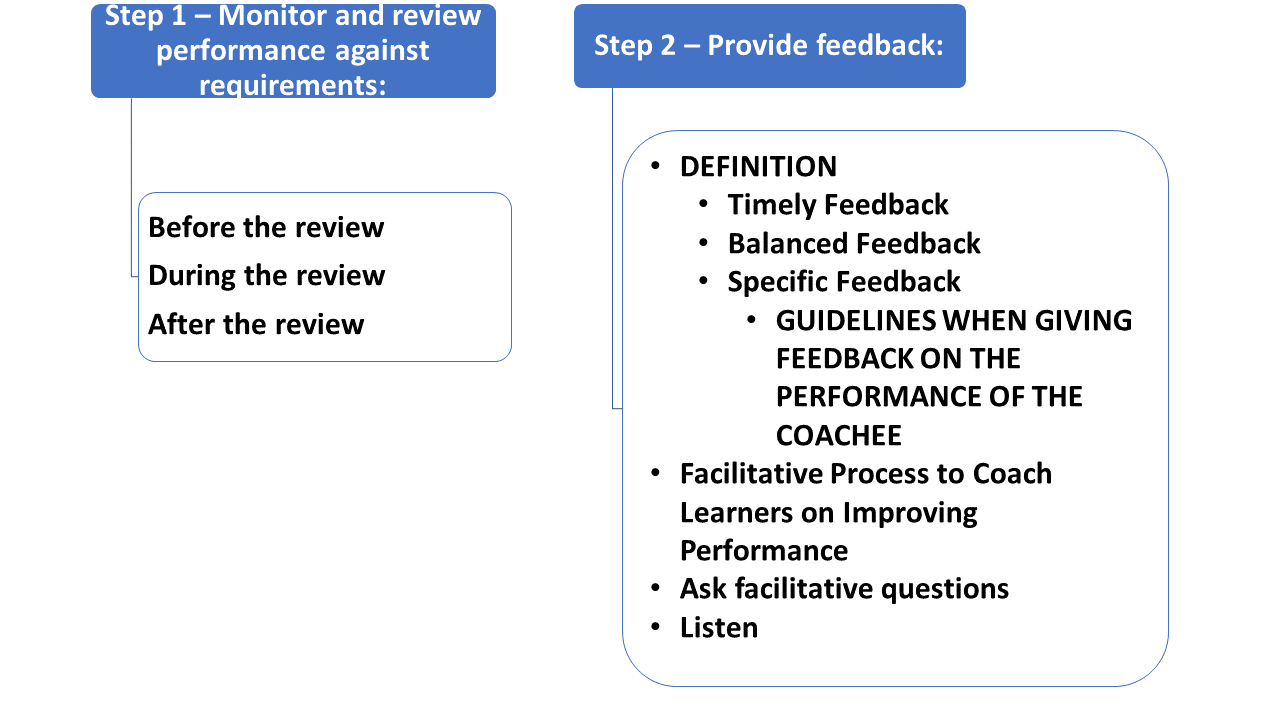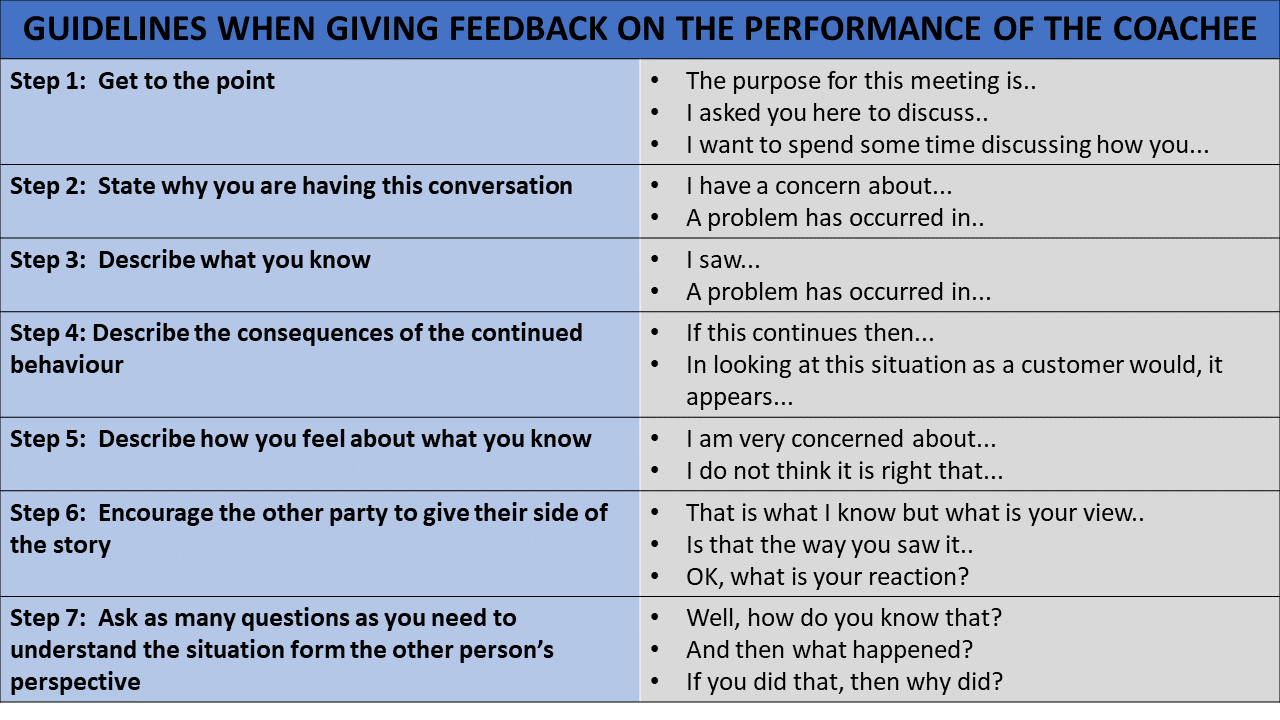Click here to view a video that explains feedback.

Monitoring and review is primarily a means of reinforcing the knowledge that contributions are recognized and valued. It is not an isolated event, but rather an ongoing process that takes place continuously. Monitoring means consistently measuring performance and providing ongoing feedback to coaches or learners on their progress toward reaching their goals.
Ongoing monitoring provides the coach the opportunity to check how well coaches/learners are meeting predetermined standards and to make changes to unrealistic or problematic standards. By monitoring continually, coaches can identify unacceptable performance at any time during the appraisal period and provide assistance to address such performance rather than wait until the end of the period when summary rating levels are assigned.
Ways through which performance can be observed include:
- Direct observation and feedback;
- Specific work results (tangible, observable evidence that can be reviewed in the staff member’s absence);
- Records and reports (attendance, safety, inventory, financial records, publications);
- Constructive and/or critical comments made by others.
Step 1 – Monitor and Review Performance Against Requirements
It is important that the atmosphere in performance review meeting is positive and that both parties treat each other as equals. Make the other party feel at ease.
Remember that learners are entering the meeting with feelings of uneasiness, fear, trepidation and even hostility.
The coach’s role in this meeting is to ensure that the organisation’s performance requirements will be achieved through the action of the coaches/learners they manage.
The formal performance review has three purposes:
- To review the performance of the coachee/learner.
- To review the performance of the coach in supporting the staff member (upward feedback).
- To evaluate the progress on a learning and development plan for the coachee/learner.
Before the Review
Decide what rating you think should be awarded to the coachee/learner and write down evidence to support this view. Make sure this rating can be justified in terms of the ratings you have given in the previous formal reviews (no surprise principle).
Think about how well you have performed in supporting the work of your coachee/learner. Write down some specific examples of strong support and ideas about how to improve performance.
Think about the job performance of the coaches/learners over the past six months/year. What does this tell you about the things he/she is good at and the things he/she is not so good at? Does it point to any areas in which he/she needs development?
Consider the coachees’/learners’ performance results and think about additional skills he/she might need to successfully achieve these. Write them down and suggest them at the review meeting.
During the Review
The coachees/learners may be very anxious about this meeting, so do not do anything to aggravate the situation (being flippant, too intense, late for the meeting and so on).
To break the ice and get the learner at ease you could offer him/her something to drink, ask about hi/her personal life (family, hobbies, etc.), or ask him/her how he/she is doing lately.
Begin the review by setting the context – provide an overview of the department and organisation’s overall performance.
Start the formal review by focussing on the performance objectives.
Ask the coachee/learner to explain what rating they think they deserve for each objective respectively and let them give reasons for this rating. Support them where you feel they are right and give examples of your own.
If you think they have rated themselves too high or too low, tell them to provide specific examples and give them plenty of opportunity to question your judgement and provide their own supporting evidence.
Receiving feedback can be threatening to people. Do not become aggressive of defensive at the meeting. If this happens call “time out”.
Stick to the facts. Do not let personality differences get in the way of a productive meeting.
Carefully discuss gaps in performance and follow the facilitative approach (see below) to coach the learner on improving performance.
If there is a disagreement that you cannot resolve easily, follow the process established for reaching agreement.
If you still cannot reach agreement, you may need to resort to the formal dispute resolution process.
After the Review
As far possible, you and the coachee/learner need to reach agreement of feedback given and received. Both parties need to accept the current reality and the underlying reasons for that reality, before one can move forward by developing an action plan.
Summarise the main points of feedback. Then develop an action plan to address all of these points. Some actions might have to be taken by the coach and some by the coacher/learner. An action plan is specifically aimed at bringing performance to an acceptable level of standard.

Step 2 – Provide Feedback
Definition: Feedback is the process according to which you receive information from the external environment on both the positive and negative aspects of your performance. Feedback provides an answer to the question "How am I doing?"
Another important aspect of performance and development management is the aspect of giving and receiving feedback. Feedback answers the question: ‘How am I doing?’
Once people agree to achieve certain goals and objectives, they need to know how well they are doing.
Constructive feedback on performance and development is important because it encourages and motivates employees to perform at acceptable standards. It also helps correct mistakes and solves problems; it builds relationships between people, saves money and provides direction. People participating in a performance management process, both coaches and learners and staff members, need to know how to provide constructive feedback as well as how to receive feedback in such a manner that it will have a positive effect on performance. Open and direct criticism provides the opportunity to clear misunderstandings and correct wrong perceptions and behaviour.
Key actions that need to be performed are:
- Be honest but maintain the person’s self-esteem by providing balanced feedback. Begin and end with a positive statement. People are more receptive to corrective feedback when it is mixed with positive comments.
- Be specific about what was said or done, and state why it was effective or ineffective. Give examples of how the situation could have been handled more effectively.
- Offer alternatives. If you are giving feedback for improvement, tell the person what he or she could have said or done differently; your perspective will be helpful. Your feedback has more value and credibility when you show that you have thought of other ways to deal with the situation.

NOTE: Because coachees/learners monitor their own performance in this process, they receive much of their feedback directly, using monitoring methods established during the planning phase. As a result, they can take action whenever necessary to stay on target towards these objectives
In addition to data obtained from own monitoring sources, coachees or learners also depend on coaches for information. When they perform effectively or need to improve, you need to tell them and provide specific feedback on what they did well and what they did not do so well. Your feedback is important. It helps determine whether individuals meet objectives. For best results, your feedback should be timely, balanced, and specific.
Timely Feedback
Provide feedback as soon as possible after the incident occurs. Feedback today on something that happened this morning means much more than feedback tomorrow or the following week. The incident is still fresh in the person’s mind, so feedback will be more meaningful.
Balanced Feedback
Mix positive and constructive comments throughout the discussion where possible. Too much negative feedback might make people defensive and unwilling to communicate. If you recognise all the good performance in the beginning and leave the corrective feedback for the end, a person might feel ‘set up’. Disappointment and resentment might then replace any feeling of satisfaction. After giving corrective feedback, end the discussion with a plan for improving performance. Work closely with the staff member on the plan. The more the individual contributes to it, the more committed she will be to carry it out
Specific Feedback
A vague comment, like “You could have done a better job on that report”, does not identify the problem. It does not indicate what was wrong and how to improve. It is not the type of feedback that will help someone achieve his or her objectives. Along the same lines, general praise like “You have done a good job on that report”, also does not specify what the individual did well and should continue doing. Specific feedback explains what the individual did and why it as effective or ineffective.
Guidelines When Giving Feedback On The Performance Of The Coachee

Facilitative Process to Coach Learners on Improving Performance
Issues which indicate that there is a need for coaching include:
- Missed deadlines
- Confusion about what is required
- Poor quality work (not as required or specified)
- Complaints from others
- Your own observation of the person
- Your own observation of the product, document or process
- Repetition (i.e. not the first time) of something unacceptable
- The wrong thing is happening
Describe clearly and unambiguously your perception of what was happening when you saw or heard it. Remember, however, that you might be wrong.
Ask Facilitative Questions
Open-ended questions invite the opportunity to look at things differently, without implying blame or wrongdoing. Your responsibilities are to open windows for the employee to be able to see new possibilities.
Listen
Coaching requires you to talk less and to listen more. “Man has two ears and one mouth”, therefore, he should listen twice as much as he talks. Your role is to facilitate the thinking of your staff, not to think for them!
Listen for information, not to argue. Would you be willing to hear that the problem is yourself? Would you be willing to consider that your own endeavours and good intentions as you have been seeing them, are not working for the other person?
Effective listening is as much about sincerity and being real as it is about using listening techniques. It starts with a personal commitment and readiness to actually listen. This requires you to set aside you own ideas and ways of doing things and provide some space for another’s perceptions. Equally, the employee needs to do this for you.